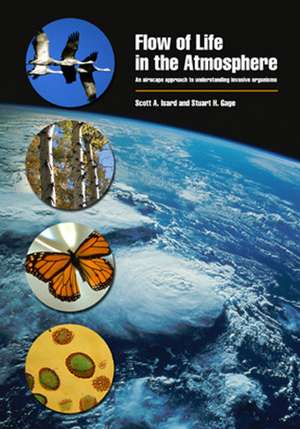Flow of Life in the Atmosphere: An Airscape Approach to Understanding Invasive Organisms
Autor Scott A. Isard, Stuart H. Gageen Limba Engleză Paperback – 30 dec 2000
As we enter the twenty-first century the ultimate objective of environmental management programs should be to manipulate ecosystems so that they fulfill the needs of humans and at the same time maintain their integrity. In this new ground-breaking work, Scott Isard and Stuart Gage look at the importance of anticipating consequences of the aerial flow of biota as new strategies to understand and manage our environment. A sound understanding of the biological and meteorological interactions that govern the movement of organisms in the atmosphere is a prerequisite to the development of successful management strategies for terrestrial ecosystems. Inflows and outflows of organisms to and from habitats can be as important as birth and death rates in regulating the dynamics of populations.
Isard and Gage focus on predicting events that destabilize relationships among organisms and between populations and their environment. This preventive management strategy is based on the premise that the ability to understand and predict dynamics of populations in an ecosystem allows for optimal and integrative use of a wide variety of methods to enhance human resource production and to reduce harmful impacts of diseases and organisms on humans. It is a paradigm that focuses on manipulating ecosystems to maintain the long-term stability of their diverse populations and the interactions among organisms and their environment. In many ecological systems, sudden and dramatic population fluctuations often result from movement of biota from one habitat to another. The design of grand plans to manage ecosystems without concern for the inflow and outflow of organisms associated with those ecosystems could be tragic.
Isard and Gage focus on predicting events that destabilize relationships among organisms and between populations and their environment. This preventive management strategy is based on the premise that the ability to understand and predict dynamics of populations in an ecosystem allows for optimal and integrative use of a wide variety of methods to enhance human resource production and to reduce harmful impacts of diseases and organisms on humans. It is a paradigm that focuses on manipulating ecosystems to maintain the long-term stability of their diverse populations and the interactions among organisms and their environment. In many ecological systems, sudden and dramatic population fluctuations often result from movement of biota from one habitat to another. The design of grand plans to manage ecosystems without concern for the inflow and outflow of organisms associated with those ecosystems could be tragic.
Preț: 240.73 lei
Nou
Puncte Express: 361
Preț estimativ în valută:
46.07€ • 47.73$ • 38.45£
46.07€ • 47.73$ • 38.45£
Carte indisponibilă temporar
Doresc să fiu notificat când acest titlu va fi disponibil:
Se trimite...
Preluare comenzi: 021 569.72.76
Specificații
ISBN-13: 9780870135507
ISBN-10: 0870135503
Pagini: 240
Dimensiuni: 178 x 254 x 18 mm
Greutate: 0.58 kg
Ediția:New.
Editura: Michigan State University Press
Colecția Michigan State University Press
ISBN-10: 0870135503
Pagini: 240
Dimensiuni: 178 x 254 x 18 mm
Greutate: 0.58 kg
Ediția:New.
Editura: Michigan State University Press
Colecția Michigan State University Press
Notă biografică
Descriere
As we enter the twenty-first century the ultimate objective of environmental management programs should be to manipulate ecosystems so that they fulfill the needs of humans and at the same time maintain their integrity. In this new ground-breaking work, Scott Isard and Stuart Gage look at the importance of anticipating consequences of the aerial flow of biota as new strategies to understand and manage our environment.
